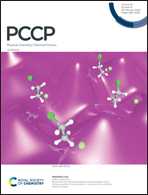Volume expansive pressure (VEP) driven non-trivial topological phase transition in LiMgBi†
Abstract
Topological Insulators (TI) exhibit robust spin-locked dissipationless Fermion transport along the surface states. In the current study, we use first-principles calculations to investigate a Topological Phase Transition (TPT) in a Half-Heusler (HH) compound LiMgBi driven by a Volume Expansive Pressure (VEP) which is attributed to the presence of, intrinsic voids, thermal perturbations and/or due to a phenomena known as cavity nuclei. We find that, the dynamically stable face-centred cubic (FCC) structure of LiMgBi (which belongs to the F![[4 with combining macron]](https://www.rsc.org/images/entities/char_0034_0304.gif) 3m[216] space group), undergoes TPT beyond a critical VEP (at 4.0%). The continuous application of VEP from 0.0% to 8.0% results in a phase transition from a, band insulator to a Dirac semi-metal nature. Qualitatively, the Dirac cone formation and band inversion along the high symmetry point Γ in the Brillouin Zone (BZ) are analysed in terms of Electronic Band Structure (EBS) and Projected Local Density of States (LDOS). The TPT is further characterised by the
3m[216] space group), undergoes TPT beyond a critical VEP (at 4.0%). The continuous application of VEP from 0.0% to 8.0% results in a phase transition from a, band insulator to a Dirac semi-metal nature. Qualitatively, the Dirac cone formation and band inversion along the high symmetry point Γ in the Brillouin Zone (BZ) are analysed in terms of Electronic Band Structure (EBS) and Projected Local Density of States (LDOS). The TPT is further characterised by the ![[Doublestruck Z]](https://www.rsc.org/images/entities/char_e17d.gif) 2 invariant, (ν0, ν1ν2ν3) ≡ (1, 0 0 0) along the (0001) surface which indicates quantitatively that, HH LiMgBi is a strong TI. We hence propose, HH LiMgBi (known for its piezoelectric, thermo-electric and semi-conducting applications) as a strong TI with potential multi-purpose application in the field of electronics, spintronics and quantum computation.
2 invariant, (ν0, ν1ν2ν3) ≡ (1, 0 0 0) along the (0001) surface which indicates quantitatively that, HH LiMgBi is a strong TI. We hence propose, HH LiMgBi (known for its piezoelectric, thermo-electric and semi-conducting applications) as a strong TI with potential multi-purpose application in the field of electronics, spintronics and quantum computation.



 Please wait while we load your content...
Please wait while we load your content...